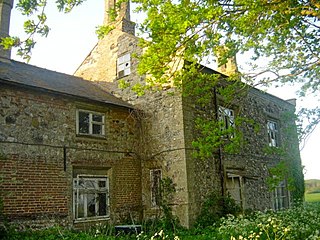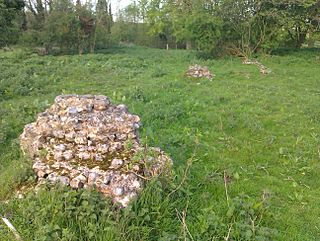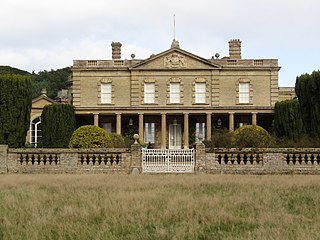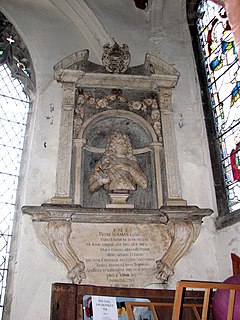Related Research Articles

Rev. Francis Blomefield, FSA, Rector of Fersfield in Norfolk, was an English antiquarian who wrote a county history of Norfolk: An Essay Towards a Topographical History of the County of Norfolk. It includes detailed accounts of the City of Norwich, the Borough of Thetford and all parishes in the southernmost Hundreds of Norfolk, but he died before completing it. This was done by a friend, Rev. Charles Parkin. The Norfolk historian Walter Rye related that although no portrait of him was known to exist, Blomefield closely resembled the astronomer John Flamsteed, whose portrait was used to depict Blomefield on the frontispiece of one of his volumes. His history of Norfolk was reissued in London in 11 volumes by William Miller in 1805–1810, the last seven being by Parkin.
Pattesley is a village in the English county of Norfolk, about one mile (1.6 km) south of the village of Oxwick. It consists of a few scattered houses. The population is included in the civil parish of Colkirk.

Thetford Priory is a Cluniac monastic house in Thetford, Norfolk, England. Founded in 1103 by Roger Bigod of Norfolk, Thetford was one of the most important monasteries of East Anglia.

Old Buckenham Castle and Buckenham Castle are two castles adjacent respectively to the villages of Old Buckenham and New Buckenham, Norfolk, England.

Fordham is a small village and civil parish in the English county of Norfolk between Hilgay and Denver near the town of Downham Market. The parish falls in the district of King's Lynn and West Norfolk It covers an area of 8.94 km2 (3.45 sq mi) and had a population of 71 in 29 households at the 2001 census. For the purposes of local government, it falls within the district of King's Lynn and West Norfolk.
Walter Fitz Robert of Woodham Walter, lord of Little Dunmow, Essex, was steward under Stephen of England, having succeeded to that position upon the death of his father, Robert Fitz Richard. Walter died in 1198 and was buried at Little Dunmow, in the choir of the priory of Austin canons.

Winnold House, formerly the Benedictine Priory of St Winwaloe, is a country house in the parish of Wereham in Norfolk, England. The house is constructed from the remaining fragments of a former Benedictine priory. The priory was founded in 1199 and was dissolved in 1321. It was demolished in 1539, and the surviving fragments were incorporated into a house sometime in the 17th century; it was rebuilt in the mid-19th century. It is a Grade II* listed building.

Hempton Priory was a medieval monastery at Hempton in Norfolk, England, variously referred to also as Fakenham or Damsend Priory.
Modeney Priory—also spelled Modney and Modeny—was a Benedictine priory in the civil parish of Hilgay, Norfolk, England. Located less than a mile east of the River Great Ouse, Modeney Priory was a cell of Ramsey Abbey. Modeney Priory was founded before 1291 and dissolved c. 1536. Its former location is now occupied by Modney Hall farmhouse. According to field research undertaken by Historic England in 1976: "There are no surface structural remains of the priory. Modney Hall has an 18th/19th c[entury] brick cased exterior, but according to a former owner parts of the interior date to the 15th [century]."

Pentney Priory was an Augustinian priory at Pentney in the district of King's Lynn and West Norfolk, Norfolk, England. The ruins of the priory, mostly comprising the flint-built gatehouse, are Grade I listed.
St. George's Priory, Thetford was a Benedictine priory on the Suffolk side of Thetford, England. It was located at the current site of the British Trust for Ornithology, South of Nuns Bridges Road.
Blackfriars, Thetford was a friary in Norfolk, England, which belonged to the Dominican Order. It was one of several religious houses in Thetford closed at the time of the Dissolution of the Monasteries. The site is now occupied by Thetford Grammar School.

Flixton Priory was a nunnery under a prioress following the Augustinian rule, which formerly stood in the parish of Flixton in the north of the English county of Suffolk, about 3 miles (4.8 km) south-west of Bungay. It was founded by Margery de Creke in 1258, and was dissolved in 1536–37. It was the poorest of the nunneries within the Diocese of Norwich. The site of the priory, which was enclosed by a moat, was at the present Abbey Farm, where little apart from the position in the landscape and a small section of standing wall remain to be seen. It was scheduled as an ancient monument in 1953. It is privately owned and is not open to the public. It is suggested that some parts of the masonry may have been re-used in St Peter's Hall at St Peter, South Elmham.

St Peter's Church is a redundant Anglican church in the village of Hockwold cum Wilton in Norfolk, England. It is recorded in the National Heritage List for England as a designated Grade I listed building, and is under the care of the Churches Conservation Trust.
Robert Rugge, of Norwich, Norfolk, was an English politician. He was a Member of Parliament (MP) for Norwich in 1545 and mayor of the city in 1545-46 and 1550-51.
Roger Devereux was a Norman nobleman who, following the Norman Conquest of 1066, was recorded as holding lands in Norfolk at the time of the Domesday survey of 1086.

Gunton Hall, Gunton Park, is a large country house near Suffield in Norfolk.
Richard Fulmerston, of Ipswich, Suffolk and Thetford, Norfolk, was an English politician, entrepreneur, and philanthropist.
Guton was a settlement in the county of Norfolk in England mentioned in the Domesday Book as Guthetuna. It is described as being held by Osbert from Tihel le Breton. It had a mill and 14 beehives. It was considered a small town with 40 households. Lestan, a freeman, was deprived of it on the Norman conquest.

Sir Peter Seaman (1662–1715), Knight Batchelor, of the City of Norwich in Norfolk, England, was a brewer who served as Mayor of Norwich 1707-8, Colonel of the City Corps and High Sheriff of Norfolk in 1710.
References
- 1 2 "Slevesholm Priory". Heritage Gateway. Historic England. n.d. Retrieved 28 November 2022.
- ↑ Blomefield, Francis (1805). An Essay Towards a Topographical History of the County of Norfolk. Vol. 2. William Miller. p. 210 – via British History Online.
Coordinates: 52°32′07″N0°30′31″E / 52.5353451°N 0.5086863°E